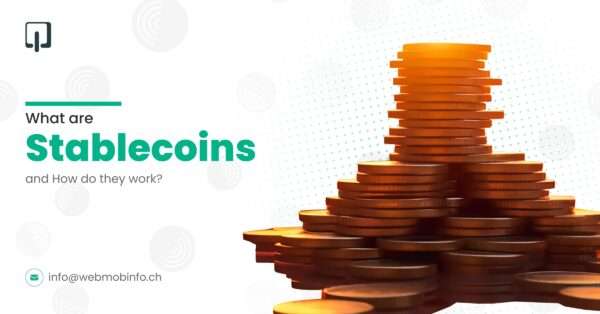Cryptocurrencies have become very popular in the global market, but these currencies are very volatile, making their use risky. Then there are stablecoins, which were created to provide stability in the market. Stablecoins, which are pegged to stable assets, bring the advantages of digital currencies without the volatility of the price, which is why they are an essential part of the blockchain environment. This blog discusses stablecoins, how they work, the various types of stablecoins, and why they are important.
TABLE OF CONTENT
What are stablecoins?
Stablecoins can be defined as cryptocurrencies that are anchored on another commodity, such as fiat currency (for instance, USD) or other commodities like gold. In contrast to the original cryptocurrencies, such as Bitcoin and Ethereum, whose values tend to be highly volatile, stablecoins provide more stability, which makes them appealing to both investors and users.
The goal of stablecoins is to provide a cryptocurrency token with a stable value, which is often attained by pegging the token to an asset like gold or fiat. The market is more confident in their valuation since they are supported by more conventional assets. For this reason, stablecoins are often the preferred choice for cryptocurrency users, both institutional and individual.
How do stablecoins work?
Stablecoins use various methods to ensure that their value is stable. Here’s how stablecoins work in various setups:
1. Fiat-Collateralized Stablecoins
Such stablecoins are anchored to fiat currency that is kept in reserve. For instance, any issued amount of a fiat-collateralized stablecoin such as Tether (USDT) has an equivalent value in USD held in a bank. One-to-one backing gives the users confidence that they can exchange their stablecoins for fiat currency at any given time.
2. Crypto-Collateralized Stablecoins
Rather than fiat, these stablecoins are collateralized by other cryptocurrencies. For instance, Dai (DAI) is anchored to the USD but collateralized by Ethereum (ETH). Due to the high volatility of cryptocurrencies, crypto-collateralized stablecoins are usually over-collateralized; that is, the sum of the collateral is higher than the issued stablecoins.
3. Algorithmic Stablecoins (Non-Collateralized)
These stablecoins apply specific algorithms and smart contracts to manage the supply of the stablecoin by increasing or reducing it to reflect the demand. They are not fiat or crypto-collateralized stablecoins as they do not have any link to any underlying asset, but they use market prices and formulas to maintain price stability.
Types of stablecoins:
Understanding the different types of stablecoins is crucial for recognizing their unique advantages and limitations.
1. Fiat-Collateralized Stablecoins
Tether (USDT): Tether is one of the most popular types of stablecoins and is pegged to the value of the US dollar. For every USDT issued, an equivalent amount of USD is held in reserve by Tether Limited.
USD Coin (USDC): USD Coin is an example of a stablecoin fully backed by US dollars in reserve. It was jointly developed by Circle and Coinbase. Every USDC is equal to one US dollar, giving it price stability.
TrueUSD (TUSD): TrueUSD is a fiat-collateralized stablecoin that is backed 1:1 with USD held in trust accounts. TrustToken, the issuer of TUSD, is transparent in providing attestations of the reserves by third-party auditors from time to time.
2. Crypto-Collateralized Stablecoins
Dai (DAI): Dai is a decentralized stablecoin that is created by the MakerDAO protocol. This stablecoin is secured by several cryptocurrencies, mainly Ethereum.
sUSD (Synthetix USD): sUSD is a stablecoin issued by the Synthetix protocol, backed by the platform’s native token with SNX and other assets. sUSD is applied in the Synthetix network as a medium of exchange for Synthetix assets to ensure stability and market depth.
3. Algorithmic Stablecoins
Ampleforth (AMPL): Ampleforth is an algorithmic stablecoin that autonomously changes its total supply to meet market demand and maintain a stable value. Yet, it should be noted that AMPL is not a fiat or crypto-collateralized stablecoin that is backed by assets.
TerraUSD (UST): TerraUSD is another algorithmic stablecoin created by Terraform Labs. It holds its value against the dollar by having Terra (LUNA) and UST tokens linked together.
Why are stablecoins important?
Stablecoins are indispensable in the blockchain ecosystem and in the world in general. Here’s why they matter:
1. Reducing Volatility
Stablecoins provide relief from the fluctuations of conventional crypto assets and let users store their wealth in digital assets.
2. Facilitating Transactions
For this reason, stablecoins are perfect for use in daily transactions and, especially in remittances. They facilitate faster and less expensive foreign remittances than the conventional banking channels.
3. Enhancing Liquidity
Stablecoins bring liquidity to the crypto markets. In trading, traders employ stablecoins to quickly go long or short without having to switch to fiat currency.
4. Enabling Decentralized Finance
Stablecoins are the foundation for numerous DeFi applications since they enable lending, borrowing, and receiving interest without involving highly unpredictable coins.
5. Promoting Financial Inclusion
Stablecoins can offer the unbanked and underbanked population access to a stable digital currency that they can buy with a smartphone.
Examples and List of Stablecoins
Here’s a table summarizing some of the most popular stablecoins and their key characteristics:
| Stablecoin | Type | Backing Asset | Use Case |
| Tether (USDT) | Fiat-Collateralized | USD | Trading, remittances |
| USD Coin (USDC) | Fiat-Collateralized | USD | Payments, DeFi |
| Dai (DAI) | Crypto-Collateralized | Ethereum (ETH) | DeFi, lending, borrowing |
| sUSD | Crypto-Collateralized | Synthetix Network Token | DeFi, trading |
| Ampleforth (AMPL) | Algorithmic | Algorithmic adjustment | Trading, DeFi |
| TerraUSD (UST) | Algorithmic | Algorithmic adjustment | Payments, DeFi |
| Paxos Gold (PAXG) | Commodity-Collateralized | Gold | Trading, investing |
| Digix Gold (DGX) | Commodity-Collateralized | Gold | Trading, investing |
Summing Up
Stablecoin is now an essential component of the cryptocurrency market because it has been actively developing the necessary stability that is lacking in many cryptocurrencies. Based upon the characteristics of the fiat-collateralized, crypto-collateralized, and algorithmic stablecoins, you can have a better understanding of how such tokens maintain value and serve a range of purposes in the crypto ecosystem. Stablecoins are an excellent option if you need a reliable medium of exchange or a store of value.
We at Webmob Software offer customized stablecoin development solutions that meet your business’s requirements. As we are a leading blockchain development company, we are experienced in understanding the crypto market and assisting you in using stablecoins in your business. Contact us to know more about our stablecoin development services and how we can assist you in the fast-growing world of digital finance.
Chahat has a deep passion for leveraging blockchain technology to drive innovation and transformation. With over seven years of experience, she has been instrumental in guiding WebMob through the complexities of blockchain adoption. Her expertise and forward-thinking approach make her a key thought leader in the blockchain space, paving the way for a modern decentralized industry.

